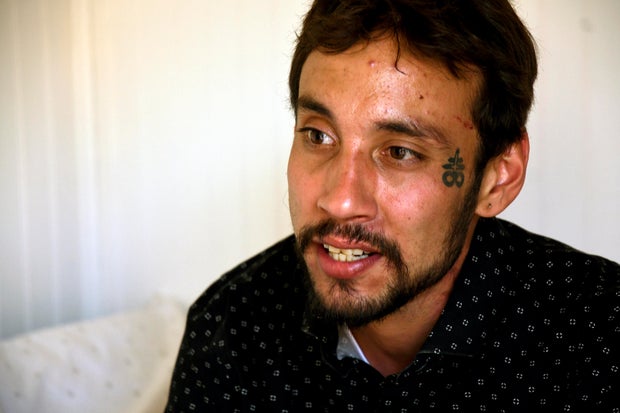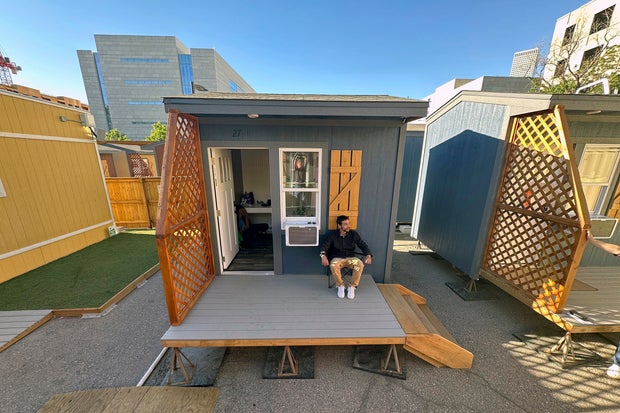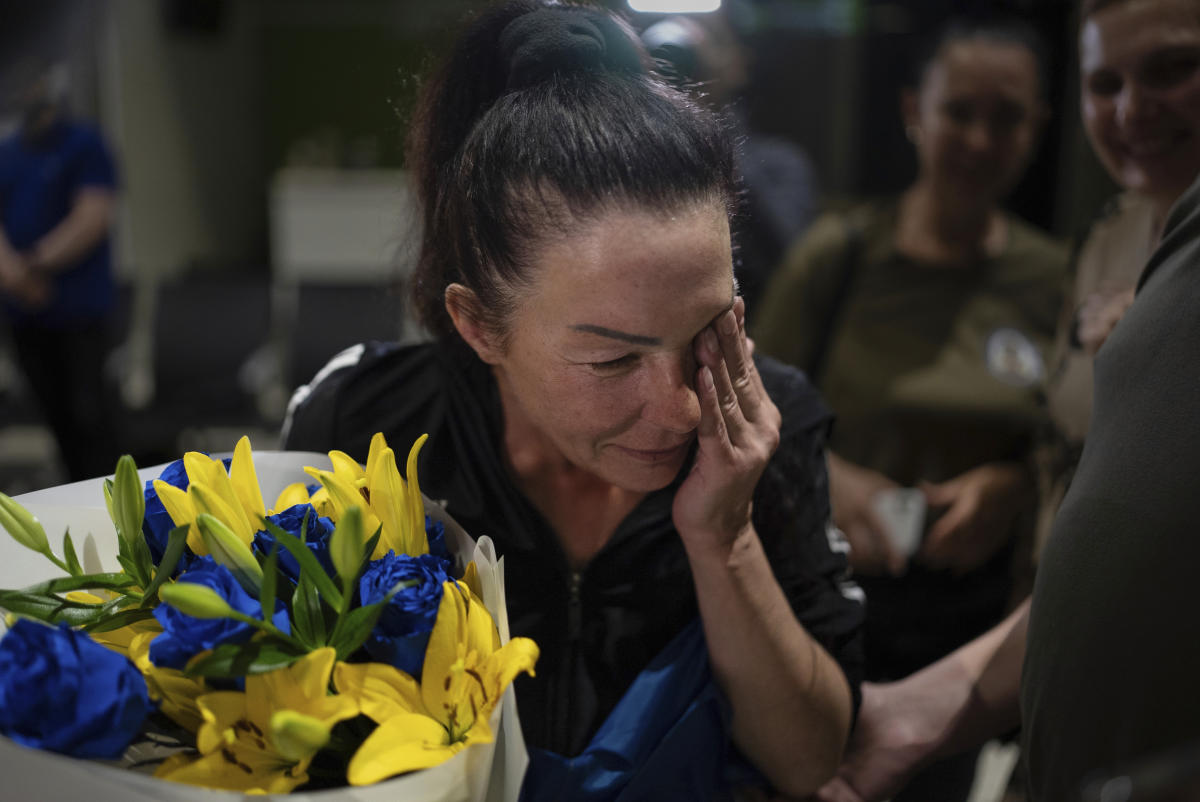In a bleak part of downtown Atlanta, shipping containers have been transformed into an oasis for dozens of previously unsheltered people who now proudly call a former parking lot home.
The gated micro-community known as “The Melody” no longer looks like a parking lot. Artificial grass is spread over the asphalt. Potted plants and red Adirondack chairs abound. There is even a dog park.
The shipping containers are divided into 40 insulated studio apartments, including a single bed, HVAC unit, desk, microwave, small refrigerator, TV, sink and bathroom. On a recent afternoon, a half-dozen residents sat chatting around a table in The Melody’s smoking area.
John Bazemore/AP
“I’m so grateful,” said Cynthia Diamond, a 61-year-old former chef who uses a wheelchair and was chronically homeless. “I have my own door key. I don’t have to worry about anyone knocking on my door and telling me when to eat, sleep or do anything else. I’ll stay here as long as the Lord allows me to stay here.” .”
Faced with years of rising homelessness rates and failed solutions, city officials across the U.S. have embraced quick housing options, emphasizing three factors: small, fast and cheap. Officials believe that micro-communities, unlike shelters, provide stability that, when combined with wrap-around services, can more effectively move residents toward safe housing.
Sprout all over the country
Denver has opened three micro-communities and converted another five hotels for formerly homeless people. In Austin, Texas, there are three “tiny house” towns. In Los Angeles, a 232-unit complex consists of two three-story buildings with stacked shipping containers.
“Housing is a ladder. You start on the very first rung. People who are literally sleeping on the floor aren’t even on the first rung,” said Denver Mayor Mike Johnston, sitting in one of the city’s new micro-communities that house small , transitional housing for that first sport.
More than 1,500 people have moved in through the program, with more than 80% still living in housing as of last month, according to city data. The low-cost housing is an especially boon for cities with high housing costs, where it wouldn’t be financially feasible to move so many people directly into apartments.
Both Atlanta and Denver’s program acts as a stepping stone in their efforts to get people jobs and more permanent housing, with Denver aiming to move people within six months.
That includes Eric Martinez, 28, who has spent most of his life in limbo between the street and the bottom step. At birth, Martinez was thrown into the revolving door of a foster home, and he struggled with substance use while couch surfing and pitching tents.
Thomas Peipert / AP
“It’s kind of humiliating, it makes me feel like less of a person,” Martinez said, eyes downcast. “I had to get out and take care of myself at that moment: it’s fight or flight, and I flew.”
Martinez’s tent camp in Denver was swept and he and the others were led into the micro-communities of small hut-like structures with a single bed, a desk and a closet. The city built three such communities totaling nearly 160 units in about six months, at a cost of about $25,000 per unit, Johnston said. The 1,000 converted hotel units cost about $100,000 each.
The micro-community grounds include bathrooms, showers, laundry machines, small dog parks and kitchens, although the Salvation Army delivers meals.
The program is a reversal of policies that for years focused on short-term group shelters and the relentless shifting of encampments from one city block to another. That system made it difficult to keep people spread across the city connected to services and on the path to permanent housing.
Thomas Peipert / AP
These services in the micro-communities of Denver and Atlanta are largely centralized. They provide residents with case management, counseling, mental health and substance abuse therapy, housing assistance and assistance in obtaining everything from job skills training to new dentures.
“We are able to meet every level of the hierarchy of needs – from safety and shelter, all the way to self-actualization and sense of community,” says Peter Cumiskey, the Atlanta location’s physician.
The Melody, and others like it, are a “promising, feasible and cost-effective way” to address homelessness, said Michael Rich, a professor of political science at Emory University who studies housing policy. Rich noted that temporary housing is just the first step toward permanent housing.
The programs in Denver and Atlanta, inspired by similar programs in cities such as Columbia, South Carolina, and Savannah, Georgia, provide a level of privacy and security not found in congregate shelters or encampments.
Giving each resident their own bathroom and kitchen is a crucial feature that sets The Melody apart, says Cathryn Vassell, whose nonprofit, Partners For Home, oversees the micro-community. Aside from a ban on overnight guests, staff emphasize that tenants are treated as independent residents.
Vassell acknowledged that it is unclear how long the containers will last; she hopes for twenty years. But, she said, they were the right choice for The Melody because they were relatively inexpensive and already had handicapped-accessible bathrooms, as many were used by Georgia hospitals during the COVID-19 pandemic.
The project, which took only about four months to complete, cost about $125,000 per unit — not “tremendously cheap,” Vassell said, but less than traditional construction, and much faster. Staffing and security operations cost approximately $900,000 per year.
City officials want to expand rapid-fire housing
The Melody is the first part of Atlanta Mayor Andre Dickens’ goal to deliver 500 units of rapid-fire housing on city-owned land by December 2025. A point-in-time count in 2023 found that there were 738 people without shelter in Atlanta, far fewer. than many cities, but still an increase from the previous year.
“We need more tunes ASAP,” said Courtney English, the mayor’s chief policy officer.
Few objected when The Melody was announced last year, but as city officials look to expand the footprint of rapid housing development, they know local backlash is likely. That’s what Denver had to deal with.
Mayor Johnston said he visited at least 60 town halls in six months as Denver tried to identify locations for the new communities and faced pushback from local residents concerned about waste and safety.
“What they’re concerned about is their current experience of unsheltered homelessness,” Johnston said. “We had to show them not the world as it used to exist, but the world as it could exist, and now we have the proof points of what that could be.”
Ready for a move in no time
The scars of life on the streets remain with Martinez. All his belongings are prepared for a move in no time, even though he feels safe in his small house next to his cat, Appa.
The community has been “very uplifting and supportive,” he said, pausing for a moment. “You don’t get that often.”
On his wall hangs a calendar with a track orientation in pencil. The next step is to obtain a housing voucher for an apartment together with the staff.
“For some reason I always look down on myself,” he said. But “I feel like I did a pretty good job. Everyone’s pretty proud of me.”










